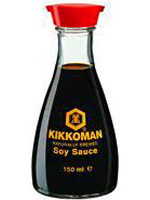 Ingredients
Ingredients-
- Monosodium glutamate
- Glucose
- Fructose
- Leucine
- Lysine
- Potassium chloride
- Lactic acid
- Succinic acid
- Acetic acid
- Alcohol
Published June 2011
Kikkoman is soy sauce which says on the bottle that it is "brewed from soybeans and wheat" and indeed these are the only ingredients which go into its production. What Kikkoman provides is a rich umami (savoury) flavour and this relies on the various natural chemicals which the fermentation process produces.
Ingredients
Monosodium glutamate (aka MSG, E621, chemical formula NaO2CCH(NH2)CH2CH2CO2H) is an amino acid and is present in every cell of our body. However, we can be intolerant of it if we take in much too much at one time although this is a rare occurrence, and so-called Chinese Restaurant Syndrome proved to be nothing more than an urban myth. MSG is an essential component of the fifth taste sensation known as umami and best described as savoury or meaty. MSG not only improves the flavour but it can be used in place of salt.
Glucose (chemical formula C6H12O6) is the simplest and most abundant carbohydrate produced by plants, which convert it to the natural polymers starch and cellulose.
Fructose (aka fruit sugar, chemical formula C6H12O6) is the carbohydrate which provides the sweetness of honey and treacle, and is almost twice as sweet as sugar.
Leucine (aka E641, chemical formula (CH3)2CHCH2CH(NH2)CO2H) is an essential amino acid from which protein is created. It is called essential because it has to be part of our diet since we cannot synthesise it within the body, as we can with most amino acids. Leucine is present in soya, maize and wheat proteins.
Lysine (chemical formula NH2CH2CH2CH2CH(NH2)CO2H) is also an essential amino acid and this is present in red meat, eggs, beans, fish, and soya.
Potassium chloride (E508, chemical formula KCl) is the potassium equivalent of common salt (sodium chloride) and like salt it is essential for the working of the nervous system. It is also a key agricultural fertilizer when it is known as MoP (muriate of potash).
Lactic acid (aka milk acid, E270, chemical formula CH3CH(OH)CO2H) is present in milk, bread, cheese, meats, beers, and wines. Lactic acid is produced in the human body in large amounts as a by-product of the metabolism of carbohydrates. (In fact we emit a little lactic acid on our breath and this is what mosquitoes use to locate us.) Lactic acid is a component of human skin and essential for keeping it in good condition, and on this basis is added to skin preparations, ostensibly to reduce wrinkles. Naturally produced lactic acid is used to make the sustainable polymer polylactic acid (aka PLA) for transparent packaging and textiles.
Succinic acid (aka butanedioic acid, E363, chemical formula HO2CCH2CH2CO2H) is used industrially to make dyes, perfumes, resins, medicines, etc., as well as being used as a food additive for dough to make bread and confectionary. It makes the dough more pliable.
Acetic acid (aka vinegar, E260, chemical formula CH2CO2H) in soy sauce is produced by anaerobic fermentation of carbohydrates, whereas that for making products such as adhesives (polyvinyl acetate), cigarette filters (cellulose acetate), and aspirin (acetyl salicylate) is produced industrially from methanol which is made from natural gas.
Alcohol (aka ethanol, chemical formula CH3CH2OH) is the sustainable fuel of the future.